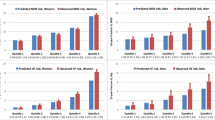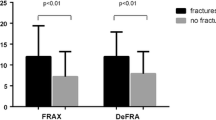Abstract
The value of bone mineral density (BMD) measurements to stratify fracture probability can be enhanced in a case-finding strategy that combines BMD measurement with independent clinical risk indicators. Putative risk indicators include age and gender, BMI or weight, prior fracture, the use of corticosteroids, and possibly others. The aim of the present study was to develop a mathematical framework to quantify the impact of using combinations of risk indicators with BMD in case finding. Fracture probability can be expressed as a risk gradient, i.e. a relative risk (RR) of fracture per standard deviation (SD) change in BMD. With the addition of other continuous or categorical risk indicators a continuous distribution of risk indicators is obtained that approaches a normal distribution. It is then possible to calculate the risk of individuals compared with the average risk in the population, stratified by age and gender. A risk indicator with a gradient of fracture risk of 2 per SD identified 36% of the population as having a higher than average fracture risk. In individuals so selected, the risk was on average 1.7 times that of the general population. Where, through the combination of several risk indicators, the gradient of risk of the test increased to 4 per SD, a smaller proportion (24%) was identified as having a higher than average risk, but the average risk in this group was 3.1 times that of the population, which is a much better performance. At higher thresholds of risk, similar phenomena were found. We conclude that, whereas the change of the proportion of the population detected to be at high risk is small, the performance of a test is improved when the RR per SD is higher, indicated by the higher average risk in those identified to be at risk. Case-finding strategies that combine clinical risk indicators with BMD have increased efficiency, while having a modest impact on the number of individuals requiring treatment. Therefore, the cost-effectiveness is enhanced.



Similar content being viewed by others
References
Eddy DM, Johnston CC, Cummings SR, Dawson-Hughers B, Lindsay R, Melto LJ et al (1998) Osteoporosis: review of the evidence for prevention, diagnosis and treatment and cost-effectiveness analysis. Osteoporos Int 8 [Suppl 4]:1–88
Royal College of Physicians (1999) Clinical guidelines for strategies to prevent and treat osteoporosis. Royal College of Physicians, London
Kwaliteitsinstituut voor de Gezondheidszorg CBO (2002) Osteoporose: tweede herziene richtlijn. Utrecht, The Netherlands. ISBN 90-76906-23-8
Kanis JA, Delmas P, Burckhardt P, Cooper C, Torgerson D, on behalf of the European Foundation for Osteoporosis and Bone Disease (1997) Guidelines for diagnosis and management of osteoporosis. Osteoporosis Int 7:390–406
Kanis JA (2002) Diagnosis of osteoporosis and assessment of fracture risk. Lancet 359:1929–1936
Kanis JA, Oden A, Johnell O, Jonsson B, de Laet C, Dawson A (2001) The burden of osteoporotic fractures: a method for setting intervention thresholds. Osteoporos Int 12:417–427
Klotzbuecher CM, Ross PD, Landsman PB, Abbot TA, Berger M (2000) Patient with prior fractures have an increased risk of future fractures: a summary of the literature and statistical synthesis. J Bone Miner Res 15:721–39
Kanis J, Johnell O, Oden A, De Laet C, Jonsson B, Dawson A (2002) Ten-year risk of osteoporotic fracture and the effect of risk factors on screening strategies. Bone 30:251–258
World Health Organization (1994) Assessment of fracture risk and its application to screening for postmenopausal osteoporosis. WHO Technical Reports Series, No. 843. WHO, Geneva
De Laet CE, van Hout BA, Burger H, Hofman A, Pols HA (1997) Bone density and risk of hip fracture in men and women: cross sectional analysis. BMJ 315:221–225
De Laet CE, Van Hout BA, Burger H, Weel AE, Hofman A, Pols HA (1998) Hip fracture prediction in elderly men and women: validation in the Rotterdam study. J Bone Miner Res 13:1587–1593
Marshall D, Johnell O, Wedel H (1996) Meta-analysis of how well measures of bone mineral density predict occurence of osteoporotic fractures. BMJ 312:1254–1259
SPSS (1999) SPSS for Windows, version 10. SPSS, Chicago
Cummings SR, Nevitt MC, Browner WS, Stone K, Fox KM, Ensrud KE, Cauley J, Black D, Vogt TM (1995) Risk factors for hip fracture in white women. Study of Osteoporotic Fractures Research Group. N Engl J Med 332:767–773
Burger H, van Daele PL, Algra D, Hofman A, Grobbee DE, Schutte HE, Birkenhager JC, Pols HA (1994) Vertebral deformities as predictors of non-vertebral fractures. BMJ 309:991–992
Dargent-Molina P, Favier F, Grandjean H, Baudoin C, Schott AM, Hausherr E, Meunier PJ, Breart G (1996) Fall-related factors and risk of hip fracture: the EPIDOS prospective study. Lancet 348:145–149
Burger H, De Laet C, Weel A, Hofman A, Pols HAP (1999) Added value of bone mineral density in hip fracture risk scores. Bone 25:369–374
Black DM, Palermo L, Abbot T, Johnell O (1998) SOFSURF: a simple useful risk factor system can identify the large majority of women with osteoporosis. Bone 23:S605
Cadarette SM, Jaglal SB, Kreiger N, McIsaac WJ, Darlington GA, Tu JV (2000) Development and validation of the osteoporosis risk assessment instrument to facilitate selection of women for bone densitometry. Can Med Assoc J 162:1289–1294
Cadarette SM, Jaglal SB, Murray TM (1999) Validation of the simple calculated osteoporosis risk estimation (SCORE) for patient selection for bone densitometry. Osteoporos Int 10:85–90
Geusens P, Hochberg MC, van der Voort DJM et al (2002) Performance of risk indices for identifying low bone density in postmenopausal women. Mayo Clinic Proc 77:629–637
Koh LK, Sedrine WB, Torralba TP, Kung A, Fujiwara S, Chan SP, Huang QR, Rajatanavin R, Tsai KS, Park HM, Reginster JY (2001) A simple tool to identify Asian women at increased risk of osteoporosis. Osteoporos Int 12:699–705
Van Muhlen D, Lunde AV, Barret-Connor E, Bettencourt R (1999) Evaluation of the simple calculated osteoporosis risk estimation (SCORE) in older women: the Rancho Bernard Study. Osteoporos Int 10:79–84
Acknowledgements
We are grateful to the Alliance for Better Bone Health, Hologic, IGEA, Lilly, Lunar, Novartis, Pfizer, Roche, Wyeth, and the EU (FP3/5) for supporting this study and the International Osteoporosis Foundation, the International Society for Clinical Densitometry, and the National Osteoporosis Foundation for their unrestricted support of this work.
Author information
Authors and Affiliations
Corresponding author
Appendix
Appendix
In this appendix we detail the derivation of the formulae.
Let X denote a risk variable for fracture or a combination of risk variables, which we assume to have a normal distribution. Without loss of generality we can assume that the mean is zero and the standard deviation is 1. The hazard function of fracture when X=x is given by:
The expected value E[exp(β0+β1X)] has to be equal to 1 in order to give an average risk equal to that of the population. We use the following general relationship: if Y has a normal distribution with mean μ and standard deviation σ, then E[exp(Y)]=exp(μ+σ2/2). The variable β0+β1X has a normal distribution with mean β0 and standard deviation β1.
Therefore, E[exp(β0+β1X)]=exp(β0+β12/2) and the condition that the mean is 1 implies that β0=−β12/2.
The definition of a gradient of risk (GR) for the variable X implies that an increase of 1 standard deviation corresponds to a risk ratio of GR. Moreover, the standard deviation of X is 1. Thus, exp(β0+β1(x+1))/exp(β0+β1x)=GR. This implies that β1=ln(GR), and we find that β0=−ln(GR)2/2. If the value x of the risk variable X exceeds a specific risk threshold level (RT), then, exp(β0+β1x)>RT, and thus, x>(ln(RT)−β0)/β1. The probability of this event is therefore given by
where Φ is the cumulative distribution function of the standardized normal distribution, and z is given by
Let z=−(ln(RT)−β0)/β1 The average risk (AR) in the group above the chosen risk threshold relative to the average risk in the general population is then given by
Since exp(β0+β12/2)=1, this becomes
Rights and permissions
About this article
Cite this article
De Laet, C., Odén, A., Johansson, H. et al. The impact of the use of multiple risk indicators for fracture on case-finding strategies: a mathematical approach. Osteoporos Int 16, 313–318 (2005). https://doi.org/10.1007/s00198-004-1689-z
Received:
Accepted:
Published:
Issue Date:
DOI: https://doi.org/10.1007/s00198-004-1689-z




